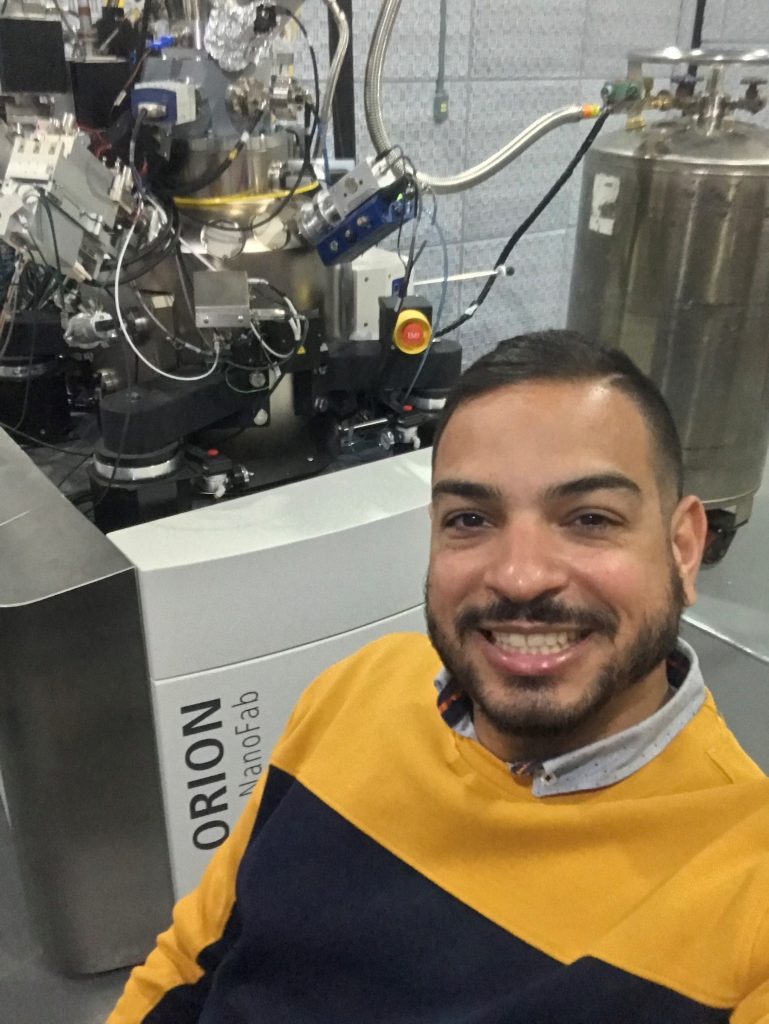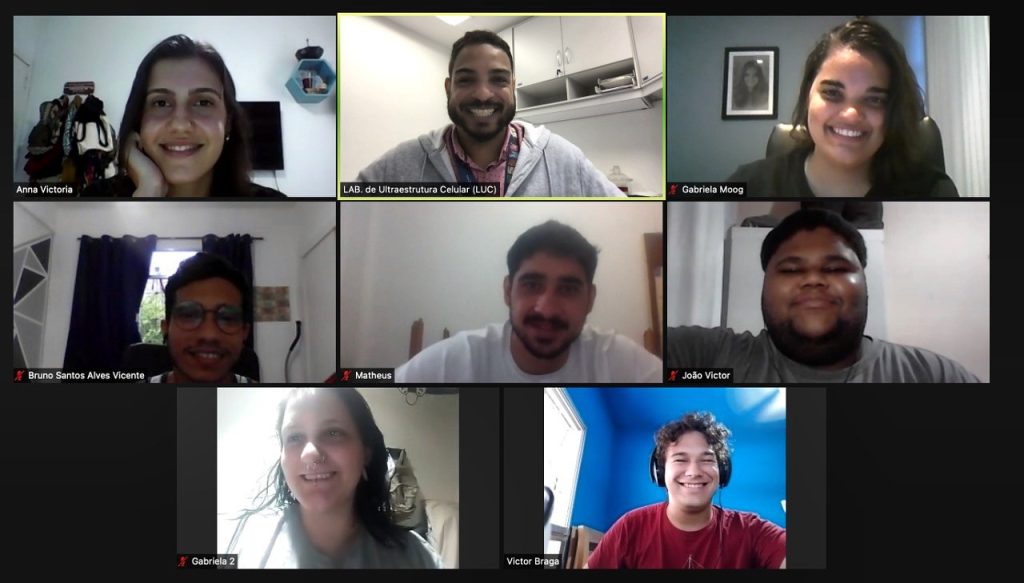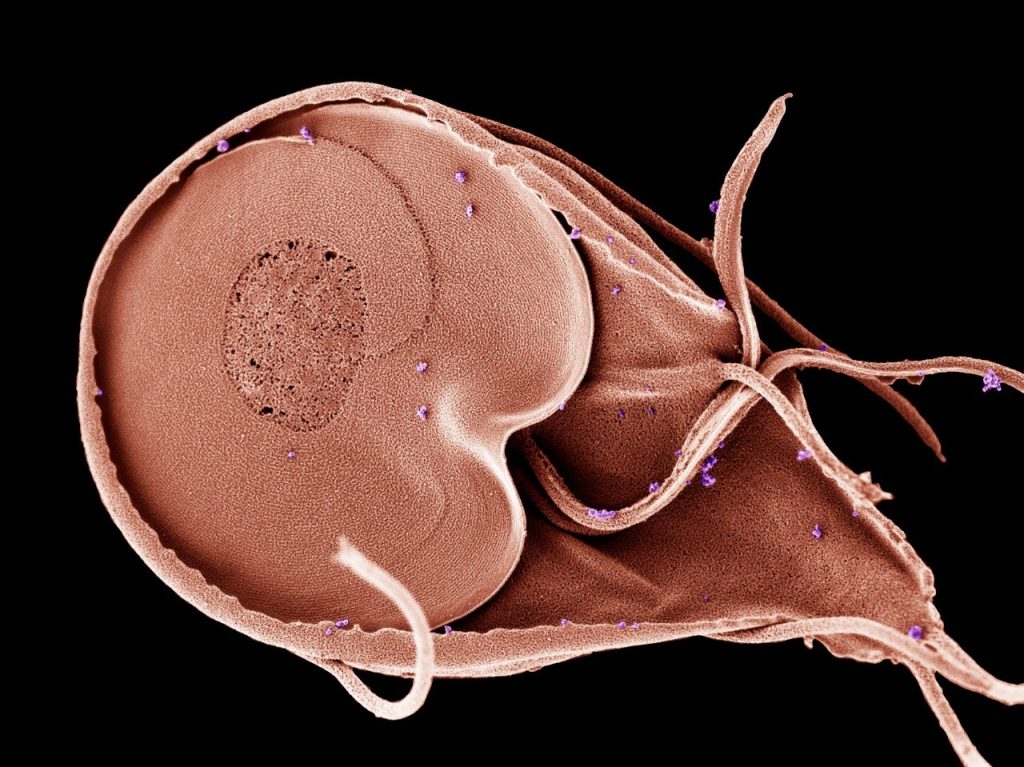An interview with Victor Midlej
Posted by Mariana De Niz, on 12 April 2022

MiniBio: Dr. Victor Midlej is a group leader at Fundação Oswaldo Cruz, working at the interface of microscopy and parasitology, focusing on cell biology, ultrastructure and chemotherapy. He has worked as a microscopist since early in his studies in 2003. Victor began his career (MSc and PhD) at the Universidade Federal do Rio de Janeiro, in the lab of Dr. Marlene Benchimol. During his early career, he worked for a short period at the University of California at San Diego. He later did a postdoc focusing on the parasite Giardia intestinalis at the Instituto de Biofisica Carlos Chagas Filho at the Universidade Federal do Rio de Janeiro, in the lab of Prof. Wanderley de Souza. His expertise in microscopy includes a plethora of techniques related to electron microscopy. Victor has significant collaborations with other Latin American researchers in Argentina and Mexico. Moreover, he is a member of the Brazilian Society of Microscopy and Microanalysis, and is heavily involved in teaching microscopy at multiple levels, and in various institutes.
Brazil has a long-standing history of contributions to science both, in Latin America and world-wide. It is the land of scientists as renowned as Carlos Chagas and Oswaldo Cruz. It is also a country of fascinating biodiversity, attractive the whole world around. Before becoming a scientist, were you aware of this heritage? What inspired you to become a scientist?
I was born in the countryside of Brazil, not the capital or any big city like Rio de Janeiro. I come from the countryside of the state of Bahia (in Northeastern Brazil). So I wasn’t aware of much of the scientific background of the country. About being a scientist, this concept didn’t really exist for me. As a child, I didn’t know what this profession was about. In my head, science was something that you watched in films, or a stereotype of the ‘eccentric’ scientist. However, I always had a tendency towards biological science. I was attracted to questions on biodiversity and life. From a cultural point of view, while growing up all my childhood and adolescence, I was re-directed by my family and others, to become a medical doctor because of my interest in biology. This is what was known to us. I only came face-to-face with science itself as an undergraduate, when I joined the Santa Úrsula University. I think about this a lot now, because I’ve been recently invited to talk to young students about what is science, what it entails to be a scientist, etc. I think the current pandemic has contributed to people’s curiosity on science. I’m the only person in my family who has done a PhD, and who is a scientist. And this has allowed me to convey this experience to my nephews and other children in the family, who now have a better perspective than I did, on what it is to be a scientist.
You have a career-long involvement in microscopy and infectious diseases. What inspired you to choose this career path?
I started being a microscopist since very early in my career. I did my very first internship with a very famous Brazilian microscopist, and I stayed until now. I’ve been a microscopist since 2003! A series of factors led me to choose to become a microscopist. My teacher (who was later my supervisor), Dr. Marlene Benchimol, used to teach the course of ‘Cell Biology’, and she was excellent. She has a fantastic teaching method, and she portrayed this world within microscopy as a fantastic world – fascinating for me. During the first few months, I went to her lab and saw all these machines (the microscopes), and was fascinated. I saw there an electron microscope and wondered whether I could work on this myself as a young student. I saw other young students already working there, and in my mind, this made it possible for me. Nowadays I can’t imagine doing science without microscopy.
About infectious diseases, to be honest I didn’t really decide anything. Microscopy was a main factor for my research – the involvement in infectious diseases came with the package. Without really realizing it, I had become a parasitologist-microscopist!
Brazil has renowned and historical institutions dedicated to research (and microscopy). Can you tell us a bit about what you have found uniquely positive about becoming a researcher in Brazil, from your education years?
There’s a culture in Brazil of starting ‘Iniciação cientifica’ already working on an own project and working with big microscopes. I did an internship in the USA where there’s people responsible for equipment. I think perhaps Brazilian science depends a lot more on scientific productivity, since very early on in someone’s career. I think also this early exposure to practical science and “the bench” and “the wet lab” conquests people’s hearts more than if it just remained theoretical. This incentivized students to lose fear towards microscopes, and really get involved in science. This is what was attractive to me. This is very strong as a culture in Brazil, and in specific in the center led by Prof. Wanderley de Souza, including the lab of my ex-supervisor, Marlene. There was the idea of not just watching ‘grown up’ scientists doing science, but doing it yourself. When you lose this fear early on, it’s easier to learn and even establish new methods. And this has a huge impact on your evolution as a scientist.
Throughout your career you have belonged to various world-renowned centres of microscopy? Can you tell us a bit about your path, and how did this shape you as a microscopist?
Prof. Wanderley de Souza is a ‘scientific father’ of a large number of microscopists in this country. Dr. Marlene’s lab was independent from his and in a different University. Her lab was extremely well-equipped, and there were many students. This configuration meant one had to quickly become very productive and very independent. This was only possible due to Marelene’s mentoring. At the same time, Prof. Wanderley’s lab was supportive always to learn new techniques and collaborate. His lab was very open, and his philosophy is that once you have been a part of this lab, you will always remain a member. So people really belong, and remain highly linked, scientifically, to this great environment. This opened a whole new area for the type of research I could do, and allowed me to have contact with a large range of collaborators.
While I focused on basic research for a lot of my career, when I joined Instituto Oswaldo Cruz (Fiocruz), I realized the importance of research in parasitology in our region: Latin America is endemic to many infectious pathogens, and there is a lot of research being devoted to understand and address this. And this has impacted my focus to try and contribute to society and public health as well as working on basic research. The health system in Brazil is based on a great philosophy, which makes healthcare free to all. When I became an independent researcher, this impacted a lot my decision regarding research projects. I now focus on two main questions: one is understanding the interaction of parasites with the microbiota – both as contributing to disease, and as a player with an important anti-pathogenic role. The second is cannabis! We are testing cannabinoids for their anti-parasitic action. For both projects, microscopy will be key, because with microscopy I can imagine better the questions. My involvement in research I think has contributed to the perception of cannabis as an important player for medicinal use. I wish to convince society and communicate my research successfully. As a scientist I wish to come close to society, and I think this pandemic has shown us how important this is. Equally, my background (where I had little exposure to science early in my childhood) is an important incentive for me to really pursue this connection to the general population.

Did you have many opportunities to interact with other Latin American groups, outside of Brazil?
The groups of Marlene and Wanderley are linked to a reputation, and gives you this credibility of being a centre of excellence for microscopy. So our centre is sought after, by others in the region, to do microscopy. I myself was always open to collaborations and didn’t stick solely to my own projects, so this gave me the opportunity to work with many people. I love collaborating. Everything different triggered my curiosity, and I was always extremely keen on being involved in many projects. In Latin America, I exchange a lot with two groups in Argentina: with Dr. Hugo Luján, and with Dr. Natalia de Miguel –both have expertise in molecular biology and cell biology, and my group fills this gap in microscopy. My other collaborator in Latin America is in Mexico – the group of Dr. Adolfo Martínez Palomo, who leads a very famous and world-renowned microscopy group, with expertise complementary to mine. With his group, our interaction is based more on pioneering techniques in microscopy. Still, the huge reputation of the technological park in Brazil, has been favourable for collaborations within Latin America and other countries too.
Have you ever faced any specific challenges as a Brazilian researcher, working abroad?
As a scientist I admit I have never faced prejudice abroad. I have never felt in a position of disadvantage. In Argentina and Mexico I felt ‘at home’ really. In other countries I’ve visited s a scientist, I always felt well received.
Who are your scientific role models (both Brazilian and foreign)?
Prof. Wanderley de Souza is one of them. He loves science and microscopy. It is fantastic to talk to him, not just because of his own expertise but because he knew scientists who discovered structures we now take for granted, like the ER. Also, he did a lot for Brazil in terms of science and microscopy: he has been involved in mentoring microscopists in the entire country. It is now easy to know microscopists working in areas as remote as the Amazonia who have some direct or indirect connection to him.
My other role model is Dr. Marlene Benchimol who played a pivotal role in my scientific training. Marlene taught us that although it is common in science to follow trends, and although microscopy has been abandoned at times as a ‘trendy’ tool, time brings it back to the central stage time and again as an important ‘member’ of the scientific toolkit.
Internationally, I have realized accessibility is extremely important. Let me explain: as a participant in congresses as a student, I realized there’s a certain distance between PIs and students, which hinders interactions. Even more so, as a foreign student from Latin America. There’s a certain fear to approach senior scientists when you’re a young scientist, and some senior scientists don’t promote this contact or actively diminish this fear. Recently, I invited Dr. Bruno Humbel (in Okinawa, Japan) to give a talk, and he agreed to come to Brazil. I realized he was extremely accessible, and this became inspiring for me.
Brazil has one of the best equality in terms of gender I have encountred as a researcher, with women heavily involved in research, at various leadership levels. Was this something that influenced you? How? (eg. you were trained by women in an area which world-wide is very male-dominated)
In fact, when we analyze the number of women dedicated to science here in Brazil, the number exceeds that of men. Today we have some policies specifically aimed at women, such as increasing deadlines or production analysis time for women who became pregnant during the analysis period. I see that the women here have taken a leadership position, but I still feel that the path for them to take is a little more difficult than for the men. There is a whole cultural issue about the role of women in society, and even here in Brazil many people, including scientists, think that way. I have many references to women as a leadership and key role in the workplace: both in my family and in my professional life. I had a woman as a mentor, to whom I owe much of what I know in microscopy field and I continue to be headed by a woman, Dr. Mirian Pereira, head of the laboratory that I am currently part of at FIOCRUZ.
What is your favourite type of microscopy and why?
I have two favourite types of microscopy: one at the beginning of my career, and one now. At the beginning it was SEM. Images are extraordinary and it’s a beautiful technique. Now it’s TEM. It allows us to answer many key questions.
What is the most extraordinary thing you have seen by microscopy? An ‘eureka’ moment for you?
I think that everything new that I see under microscopy is a unique moment of discovery. Understand new, as a type of sample that has not yet been seen through the electronic microscope, or even by a more modern technique. This case reminds me of a fact: for a long time membrane profiles within a set of vesicles in Giardia, called peripheral vesicles were seen as possible folds in the membrane surrounding the vesicle, and by TEM we see the profiles depending on the orientation of the slice. We recently published that these membrane profiles are not a fold of the membrane that surrounds the vesicle, but rather multivesicular bodies. We’ve only seen this with the help of the dual-beam electron microscope (FIB) and with three-dimensional reconstruction. That moment was a ‘eureka’ for me!

What is an important piece of advice you would give to future Brazilian scientists? and especially those specializing as microscopists?
There is an advantage of Brazil, which should not be underestimated, which is the creativity and resilience in the face of reduced funding.
Also, my other piece of advice would be to lose all the fear. I know that entering a microscopy room is like entering a spaceship which already intimidates people. But you should learn to lose this fear. You don’t have to be a physicist to be able to use a microscope, although if you wish to enter this field, it is a fascinating area too. Once you understand the tool, and you know how to handle it, and how to apply it to answer your questions, you become one with it. Having this expertise will make you a vital collaborator. People will look for you to collaborate.
Where do you see the future of microscopy heading over the next decade in Brazil, and how do you hope to be part of this future?
I think Latin America has a good know-how, but technological development is hindered by lack of investment. Historically, it is the state which finances science. Funding from private industry or private companies has been relatively little compared to other countries in Europe or other regions. Perhaps a better link between them will aid research, and technology development in our region.
Also, I feel now microscopy is more valued than before. There was a time when microscopy was though of only as a descriptive technique. This recognition of microscopy as a tool to explore function will be key for the future of its use and development in Brazil.
Finally, Brazil is the largest Latin American country, and one of the largest in the world. Beyond the science, what do you think makes Brazil a special place to visit and go to as a scientist?
I think one of our biggest strengths arises from a funding disadvantage: we can do a lot with very little. We can adapt protocols, and become versatile and creative. I think while this might first come as a shock to scientists who have better access to everything, I think this would show a different reality. The reaction of many researchers who have visited us here, is happiness to see that our scientific park is well developed, and very successful in terms of infrastructure and human resources. I think Rio de Janeiro will be a good place to learn microscopy for a foreign scientist. Moreover, Brazilian scientists are very inclusive and welcoming, so it is easy to integrate. I believe this might be a common trait with other Latin Americans. Finally, I think it is extremely important for me to send this message that everyone can become a scientist, regardless of background, country of origin, or anything else.


 (No Ratings Yet)
(No Ratings Yet)